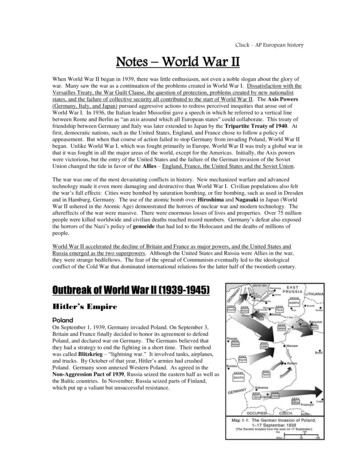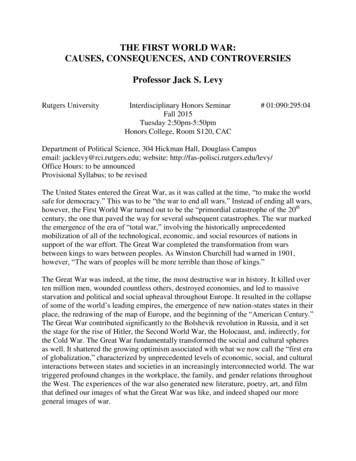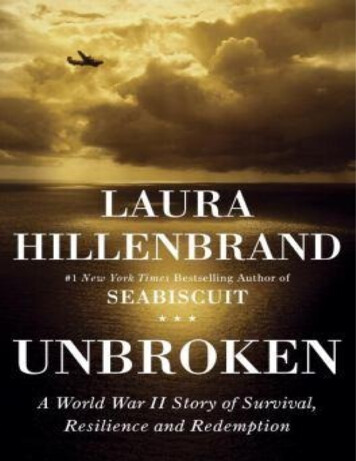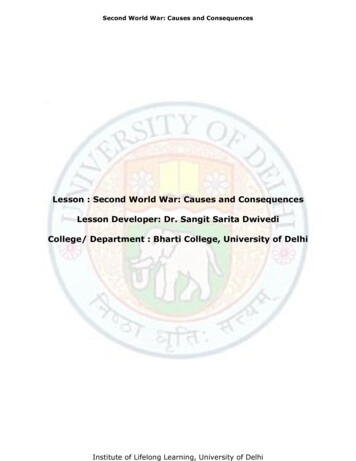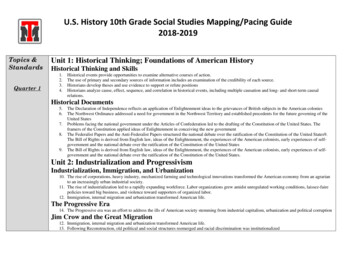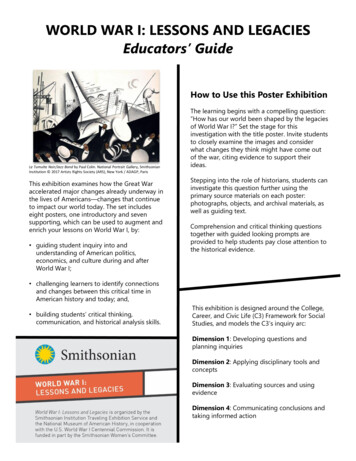
Transcription
WORLD WAR I: LESSONS AND LEGACIESEducators’ GuideHow to Use this Poster ExhibitionLe Tumulte Noir/Jazz Band by Paul Colin. National Portrait Gallery, SmithsonianInstitution 2017 Artists Rights Society (ARS), New York / ADAGP, ParisThis exhibition examines how the Great Waraccelerated major changes already underway inthe lives of Americans—changes that continueto impact our world today. The set includeseight posters, one introductory and sevensupporting, which can be used to augment andenrich your lessons on World War I, by: guiding student inquiry into andunderstanding of American politics,economics, and culture during and afterWorld War I;The learning begins with a compelling question:“How has our world been shaped by the legaciesof World War I?” Set the stage for thisinvestigation with the title poster. Invite studentsto closely examine the images and considerwhat changes they think might have come outof the war, citing evidence to support theirideas.Stepping into the role of historians, students caninvestigate this question further using theprimary source materials on each poster:photographs, objects, and archival materials, aswell as guiding text.Comprehension and critical thinking questionstogether with guided looking prompts areprovided to help students pay close attention tothe historical evidence. challenging learners to identify connectionsand changes between this critical time inAmerican history and today; and, building students’ critical thinking,communication, and historical analysis skills.This exhibition is designed around the College,Career, and Civic Life (C3) Framework for SocialStudies, and models the C3’s inquiry arc:Dimension 1: Developing questions andplanning inquiriesDimension 2: Applying disciplinary tools andconceptsDimension 3: Evaluating sources and usingevidenceDimension 4: Communicating conclusions andtaking informed action
Suggested Strategiesfor Examining the Posters &Communicating FindingsAdditional ResourcesInvestigation Stations: Have students dive deepinto one or several topics using the posters,supporting questions, and supplementaryresources. Guide students to communicate theirfindings through small group discussionsexamining the compelling question.Smithsonian’s History Explorer website,http://historyexplorer.si.eduNational Museum of American History “EngagingStudents with Primary Sources” teaching /files/PrimarySources.pdf.Panel Discussion: Challenge students to analyzethe compelling question through a facilitatedpanel discussion where students are the expertsand use the resources included in the posters asevidence to support their arguments.World War I, National Museum of American -war-iAdvertising War: Selling Americans on World War Iexhibition warBell Ringers and Exit Tickets: Engage studentsin a warm up discussion or thoughtful reflectionabout the events and lasting legacies of the waras part of your WWI unit.Modern Medicine and the Great War exhibitionwebsite, y Walk: Spark students’ interest with astructured gallery walk that prepares them togenerate their own exploration and examinationquestions.Uniformed Women in the Great War exhibitionwebsite, -warArtist Soldiers: Artistic Expression in the First WorldWar exhibition ist-soldiersThe Price of Freedom: Americans at War exhibitionwebsite, http://amhistory.si.edu/militaryhistoryPoster content by Howard Morrison, ProgramDirector for Exhibition Development at theNational Museum of American HistoryWorld War I, Library of cators’ guide content by Abby Pfisterer,Education Specialist at the National Museum ofAmerican History2
Standards AlignmentCollege, Career, and Civic Life Framework forSocial Studies State StandardsThis poster exhibition provides content andteaching strategies that align to nationalstandards of learning, including:D2.His.2.6-8. Classify series of historical eventsand developments as examples of change and/orcontinuity.Common Core Anchor Standards for Readingand WritingD2.His.14.6-8. Explain the multiple causes andeffects of events and developments in the past.CCSS.ELA-LITERACY.CCRA.R.7 Integrate andevaluate content presented in diverse media andformats, including visually and quantitatively, aswell as in words.D2.His.16.6-8. Organize applicable evidence into acoherent argument about the past.CCSS.ELA-LITERACY.CCRA.W.7 Conduct short aswell as more sustained research projects basedon focused questions, demonstratingunderstanding of the subject under investigation.D2.His.2.9-12. Analyze change and continuity inhistorical eras.D2.His.14.9-12. Analyze multiple and complexcauses and effects of events in the past.Common Core Standards for Literacy inHistory/Social StudiesD2.His.16.9-12. Integrate evidence from multiplerelevant historical sources and interpretations intoa reasoned argument about the past.CCSS.ELA-LITERACY.RH.6-8.2 Determine thecentral ideas or information of a primary orsecondary source; provide an accurate summaryof the source distinct from prior knowledge oropinions.National Standards for HistoryStandards in Historical Thinking: Standard 1: Chronological thinking Standard 2: Historical comprehension Standard 3: Historical analysis andinterpretation Standard 5: Historical issues-analysis anddecision-makingCCSS.ELA-LITERACY.RH.9-10.4 Determine themeaning of words and phrases as they are usedin a text, including vocabulary describing political,social, or economic aspects of history/socialstudies.United States History Standards, Era 7: TheEmergence of Modern America (1890-1930) Standard 2: The changing role of the UnitedStates in world affairs through World War ICCSS.ELA-LITERACY.RH.11-12.7 Integrate andevaluate multiple sources of informationpresented in diverse formats and media in orderto address a question or solve a problem.National Standards for Social StudiesTheme 2: Time, Continuity, and ChangeTheme 6: Power, Authority, and GovernanceTheme 8: Science, Technology, and Society3
SELLING THE WARCritical Thinking Questions1. Why would the U.S. government need to create an advertising campaign to persuade Americans tosupport the war effort?2. In your opinion, what do you think was the most effective strategy for rallying people’s support? Fear?Patriotism? Guilt? What current examples of advertising can you identify that use the same strategies?3. How do you think the advertising success of 100 years ago set the stage for how advertising is done now?Take a Closer LookPosters were printed bythe millions. Notice howthey are plasteredalongside or on top ofproduct advertising thatcovered nearly every inchof public space. How is thissimilar to or different fromadvertising today?Even celebrities got in onthe act. Here, Hollywoodstar Fatty Arbuckle helpsput up posters with abrush that has beendipped in a bucket ofpaste. Why would having a“celebrity endorsement”help sell the war?Pay attention to thewords and images on thecover of this sheet music.What is the title of thesong? What is the momimagining would happento her son?What can this tell youabout public opinionbefore the United States’entry into the war?What different elementsdo you see in this libertybond poster? Notice howthe German soldier isdepicted with menacingeyes and bloodied handslooming over a body ofwater, presumably theAtlantic Ocean.What strategy is thisposter using to “sell” thewar? How is it similar ordifferent to the posterfeaturing Columbia?
OVER THERECritical Thinking Questions1. What do you think it would have been like to be a soldier in the trenches? What would the experiencehave been like for those not on the front line, like nurses?2. In what ways was World War I fought differently than wars of the 19th century? How did advances intechnology change how war was fought?3. How is warfare approached today? What current examples of advanced military technology, weapons, orstrategy can you identify?Take a Closer LookThese plaster faces showthe process of makingprosthetic masks forsoldiers disfigured by war.The top row has casts ofthe soldiers’ injured faces.In the middle aresculptures of what theirfaces might have lookedlike before theirdisfigurement. On thebottom are masks for thesoldiers to wear based onthe sculptures.In 1921 President Hardingsaid war had become“cruel, deliberate, [and]scientific.” Do you agree?Pay close attention to thedetails included in thispainting of soldiersadvancing into thebarbed-wired entangledbattlefield—also knownas “no man’s land.”Compare this image tothe poem below it. Whatcan these two sources tellyou about what it waslike to be a soldier inWorld War I? What otherevidence from the postersupports your answer?Both sides used newweapons that could inflictmass casualties from adistance. What wartechnologies are shownon the poster?Look closely at thisuniform. What parts ofthe soldier are covered?What might it bedesigned to defendagainst?
OVER HERECritical Thinking Questions1. In what ways would the lives of people who moved to cities for industrial jobs change? What would havebeen different about the type of work they did?2. What opportunities do you think people were looking for when they left their homes in Europe or ruralareas in the United States to move to American cities? Was it only to take a job, or were there other possiblereasons?3. How did the need for more industrial production during the war shape the modern American economy?How did it change where population centers are in the country—is it the same today?Take a Closer LookRead the poem excerpt onthe poster and then take aclose look at this painting.Many of the people areshown carrying all of theirbelongings in bundles orsuitcases similar to the oneshown on the poster asthey migrate to take jobsin war factories.What are the ages of thepeople depicted? Look athow they are walking—what different emotionsare shown in this painting?Notice how many peopleare shown in this imageof an urban street.Now look at the map andkey below, which showpopulation density in1920. Where are therehigher populationnumbers—rural or urbanareas? How similar is thisto where people live inthe United States today?This factory producedmunitions for use in longrange artillery. Payattention to the number offlags hanging in thisfactory. How would thishave made you feel if youwere working here?United States Census Bureau
WOMEN IN THE GREAT WARCritical Thinking Questions1. What do you think it would have been like for women who joined the war effort? Exciting? Exhausting?Frustrating? Why would women have seen this as an opportunity?2. Can you think of reasons why some women felt that their service to their country earned them equalrights? Why would the fight for suffrage become more urgent during and after the war?3. Do any of the inequalities faced by women a century ago still exist today? How might the success of thewoman suffrage movement have inspired the fight for women’s rights today?Take a Closer LookNotice that these womenare wearing men’s uniformjackets. Women wouldeventually receive theirown specially designeduniforms.Wearing official uniformshelped validate women’sparticipation in the wareffort. How might this havechanged perceptions ofwomen and their ability tobe responsible and activecitizens?Women who worked inwar factories madeeverything from machineryto uniforms, similar towhat you see here. Formany women this was anew and excitingopportunity to earn theirown money and learn jobskills.Why would these jobshave become available towomen during the war?This uniform was worn bywomen in the U.S. ArmySignal Corps FemaleTelephone OperatorsUnit, as shown in theposter below.Look closely at the twoposters below. What isdifferent about how thewoman is depicted ineach one?How might these postersreflect the differentattitudes about womenand their place in societyduring the war?National Museum of American History
A WORLD SAFE FOR DEMOCRACY?Critical Thinking Questions1. What rights and freedoms do you think were limited during the war? Which groups of people may havebeen affected by this?2. How did the war either spark or increase social tensions in the United States? Why might some havewanted to suppress or ignore movements for civil rights during this time?3. Can you think of any groups that are fighting for equality today? How might the tense fights for equalrights 100 years ago have set the stage for discussions about democracy today?Take a Closer LookThe Espionage (1917) andSedition (1918) Actsmade it a crime to speakout against the war orshare any informationthat might possibly harmthe U.S.’s war effort.In the decades beforeWWI, many workers hadjoined unions thatadvocated for higherwages, safer workplaces,and shorter hours.This workplace poster callson workers to support thewar effort, stating that theycan either “co-operate” or“obstruct.”Look closely at the imagesand text of the poster—what does it means to cooperate? What might itmean to obstruct?Pay attention to thefigures in this image andwhat they represent.According to this politicalcartoon, what rights didsome Americans feel this“gag rule” suppressed?Look at this photographof suffragist Lucy Bird,taken after she wasarrested during protestsfor woman suffrage.She and other protesterswith her were laterawarded this pin by theNational Woman’s Party.What do you think itrepresents? Why wouldthe women who receivedthese pins have wornthem proudly?
MEDICINE AND WARCritical Thinking Questions1. In what ways did the field of medicine advance during World War I? How did it become more scientific?2. Why would war have caused an increase in medical innovations? How might these advancements havebenefited both soldiers and the American public?3. Can you identify any examples of innovative medical practices that are being used today? How do youthink the advancements made during World War I helped the field of medicine get to where it is now?Take a Closer LookThis painting depictswounded soldiers beingmoved off the battlefield.Notice the soldier walkingwith assistance in theforeground, the bandagedman on the stretcher, andthe fallen on the ground.Look closely at the injuredsoldiers. Can you tell ifthey have already receivedany first aid? How?Where do you think thesesoldiers are being taken?New understandingsabout germ theorychanged how injuredsoldiers were treated onthe battlefield. Thismedical belt includedpockets for steriledressing packets, iodineswabs, and antisepticgauze.How would having sterileequipment andantiseptics help savesoldiers’ lives?After the United Statesentered the war, themilitary evaluated themental and physicalcondition of over 4.7million draftees andvolunteers.Look closely at the itemsshown in this image.Name the medical toolsthat look familiar. Whatsort of information mighthave been gatheredduring theseexaminations?
A WORLD TRANSFORMEDCritical Thinking Questions1. How would you describe the national mood after the war? What do you think Americans worried wouldhappen if the United States became too involved in international affairs?2. Would it have been easy for the United States to become isolated from the rest of the world after the war?How had the United States become a global player?3. Can you think of examples of how the United States has become a global player? How might the nationalinterest in isolationism 100 years ago still influence how the United States interacts with other countriestoday?Take a Closer LookLook closely at the words,background images, andphysical appearance of thefigure in each of thesepictures. If “Over Here”refers to the United States,where is “Over There”?The figure representing“Over Here” is holding alunchbox and paycheck.What is the other figureholding? What could eachone be running towards?This cartoon shows UncleSam, representing theUnited States, with hishands tied by the Leagueof Nations. Who is holdingthe ends of the straps?What could this image tellus about the public’sopinion of this proposedalliance? Do those feelingsstill exist today?Pay attention to thefunnel—who is showntrying to immigrate tothe United States? Whatis different about thenumber of people goingin as compared to howmany are coming out?Is this cartoon in supportof or against immigrationcontrol? What evidencefrom the image supportsyour answer?
2 Suggested Strategies for Examining the Posters & Communicating Findings Investigation Stations: Have students dive deep into one or several topics u



